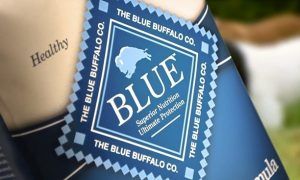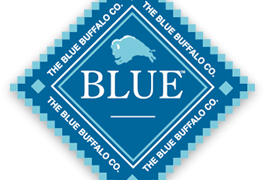“This post contains affiliate links, and I will be compensated if you make a purchase after clicking on my links.”

Last week, a panel of the National Advertising Review Board (NARB) urged the Blue Buffalo Company, Ltd., to review and revise any advertisements that make or imply their claim that other pet food manufacturers are misleading consumers.
According to a press release issued by the ASRC,
Advertising claims made by Blue Buffalo for its BLUE brand pet food products were initially challenged by Hill’s Pet Nutrition, Inc., a competing manufacturer of pet food products, before the National Advertising Division (NAD), an investigative unit of the advertising industry’s system of self-regulation.
In that underlying case, NAD examined claims that included:
- “Are big name cat foods fooling you? You probably didn’t know that many well-known cat foods contain things like chicken by-product meal and corn gluten. BLUE, on the other hand, is made with the finest ingredients ….”
- “It takes a lot to get me mad, but it really hit me when I realized that his big name dog food had chicken by-product meal as a first ingredient – not real meat. It felt like they fooled me, so I switched Leo to BLUE Buffalo.”
- “Pet parents are learning the truth about the ingredients in some of the leading dog food brands. Don’t be fooled by the big name dog food brands.”
- “These big name cat food companies are out there telling people they’re made with the best ingredients, when they’re not …. Don’t make me think I’m feeding her something high-quality when I’m not.”
The challenged claims also included a “True BLUE Test” chart that compared pet food brands and gave or withheld checkmarks.
NAD determined that the challenged advertisements reasonably conveyed the unsupported message that major pet food companies, including Hill’s, were misleading their customers by actively concealing the truth about the ingredients in their products and representing their products as being of high quality when they are not because they include lesser quality ingredients such as chicken by-product meals and corn gluten.
The NAD recommended that Blue Buffalo modify the challenged advertisements to avoid any express or implied references to competing manufacturers misleading consumers because their products include chicken/meat by-product meal or other ingredients represented by Blue Buffalo to be less nutritious. Blue Buffalo appealed this recommendation.
NAD also found that the “True BLUE Test” comparison chart reasonably conveyed the inaccurate message that the absence of checkmarks for a manufacturer meant that all of that manufacturer’s pet food products had specified “undesirable” ingredients and none of that manufacturer’s pet food products had specified “desirable” ingredients.
The NAD recommended that Blue Buffalo modify the “True BLUE Test” comparison chart by:
- specifying the number of products which include or do not include certain ingredients
- regularly monitoring product offerings of competing brands to ensure accuracy
- modifying the format of its online disclosures
- modifying its mobile disclosures
- ensuring that checkmarks appear in a uniform manner
Blue Buffalo agreed to regularly monitor product offerings of competing brands, modify its mobile disclosures, and ensure that checkmarks on its “True BLUE Test” chart appear more uniform; it appealed the remainder of the NAD’s recommendations.
Following its review of the evidence, the NARB panel determined that the challenged advertisements reasonably conveyed the unsupported message that all or most major pet food companies, including Hill’s, were misleading their customers by concealing the truth about ingredients in their products, and representing their products are high quality when they are not because they include lesser quality ingredients such as chicken by-product meal and corn gluten. The panel recommended that Blue Buffalo modify the challenged advertising to eliminate this message.
The panel noted that the challenged advertisements encouraged pet owners to visit the Blue Buffalo website to take the “True BLUE Test” comparing Blue Buffalo products to other pet food brands. The “True BLUE Test” had either checkmarks or blank spaces for the Blue Buffalo brand and competing brands in the following categories:
- ALWAYS Has Real meat as the First Ingredient
- ALWAYS Includes Veggies and Fruit
- NEVER Has Chicken (or Poultry) By-Product Meals
- NEVER Has Artificial Colors, Flavors or Preservatives
- NEVER Has Corn, Wheat, or Soy
Checks in the “True BLUE Test” were awarded or withheld based on a pet food company’s entire line – a pet food company received a check in the “ALWAYS has …” column only if every one of its pet food products had the specified ingredient, and the company received a check in the “NEVER has …” column only if none of its pet food products had the specified ingredient. However, the panel found that a significant number of reasonable consumers would understand the absence of a check in the “ALWAYS has …” column to mean that none of the company’s pet food products had the specified ingredient, and the absence of a check in the “NEVER has …” column to mean that all of the company’s pet foods had the specified ingredient. The record showed numerous examples where a competing pet food company did not receive a check even though a significant majority of its products met the specified criteria.
The panel recommended that Blue Buffalo modify its “True BLUE Test” comparison chart to clearly communicate the total number of each brand’s products and the number of those products that include or do not include specified ingredients, clearly communicate the percentage of each brand’s products which include or do not include specified ingredients, or use other methods that clearly communicate the degree to which each brand’s products include or do not include specified ingredients.
In addition, the panel recommended that any advertising referring consumers to the “True BLUE Test” be modified to make it clear that the “True BLUE Test” compares brands and avoid stating or implying that the “True BLUE Test” will enable consumers to compare specific pet food products.
Blue Buffalo, in its advertiser’s statement, said that “with all due respect to the NARB and the efforts and time of the NARB panel devoted to this matter, Blue Buffalo disagrees with the conclusions of the NARB.”
The company said that while it is not “in complete agreement with this decision, we recognize that we voluntarily committed to participate in the self-regulatory process of the NAD and the NARB. Out of respect for that process, in our future advertisements we will strive to abide by this NARB decision, as well as the guidance of other NAD decisions … .”
“We will incorporate changes to our ads and web site that are consistent with the NARB recommendations, with all due diligence,” it added.





















